The Birth of Modern Israel
And the Land of Israel Dedicated by Orson Hyde
W. Cleon Skousen, “The Birth of Modern Israel,” Ensign, May 1972, 51
The way it happened seems incredible, but it did happen.
Nearly 2500 years ago the prophet Isaiah described in vivid detail how the Jews would return to their ancient homeland in the latter days. He said, “… they shall build the old wastes, they shall raise up the former desolations, and they shall repair the waste cities, the desolations of many generations.” (Isa. 61:4).
From the Lord’s point of view the reconstruction began in America, rather than Palestine. On June 15, 1841, Orson Hyde, an apostle of the restored church, wrote a letter to the Reverend Dr. Solomon Hirschell, the leading rabbi in England, describing how the first intimation from heaven had already been received that the rise of modern Israel was imminent. Here is what he wrote:
“About nine years ago [actually 1831], a young man … in whose bosom the Almighty had deposited many secrets, laid his hand upon my head and pronounced these remarkable words—‘in due time thou shalt go to Jerusalem, the land of thy fathers, and be a watchman unto the house of Israel; and by thy hands shall the Most High do a great work, which shall prepare the way and greatly facilitate the gathering together of that people.’
This part of the letter should not have surprised the rabbi, since at every Passover, and often in their daily prayers, the Jews solemnly expressed their supreme hope of redemption by saying: “Next year, in Jerusalem!”
They had been saying this ever since A.D. 70, when Jerusalem was demolished by the Romans and the Jews were scattered to the four corners of the earth.
However, the next part of Orson Hyde’s letter no doubt startled the rabbi:
“… in the early part of March, 1840, I retired to my bed one night as usual; and while meditating and contemplating the field of my future labors, the vision of the Lord, like clouds of light, burst into my view. … The cities of London, Amsterdam, Constantinople and Jerusalem, all appeared in succession before me, and the Spirit said unto me, ‘Here are many of the children of Abraham whom I will gather to the land that I gave to their fathers; and here also is the field of your labors. … The vision continued open about six hours, that I did not close my eyes in sleep. In this time many things were shown unto me which I have never written; neither shall I write them until they are fulfilled in Jerusalem.”
We have no record of any reply from Rabbi Hirschell, but we do know what happened to Orson Hyde. A month after this great revelation, he and John E. Page were called during the April conference of the Church to fulfill a mission “to the Jews.” They were instructed to go to Palestine and dedicate that land for the gathering of the house of Israel. As it turned out, John E. Page went only as far as the east coast of the United States, but Elder Hyde continued alone and fulfilled this mission as the Prophet had instructed.
After a long and tedious excursion, Elder Hyde finally reached Jerusalem. There he prepared to dedicate that land in the exact way he had seen himself doing it during the vision. Here is the way he describes it:
“On Sunday morning, October 24 [1841], a good while before day, I arose from sleep, and went out of the city as soon as the gates were opened, crossed the brook Kedron, and went upon the Mount of Olives, and there, in solemn silence, with pen, ink, and paper, just as I saw in the vision, offered up the following prayer to Him who lives forever and ever.”
This same citation then sets forth the entire prayer, written under inspiration on this significant occasion.
The land itself was barren, unproductive, and desolate. It had been under the heel of the Ottoman Turks since 1517, and only a true believer could have seen in its coastline swamps and naked, rockstrewn mountains the possibility of a promised land.
In fact, during 1807 a body of Jewish leaders had convened in Paris under the urging of Napoleon and assured the emperor that “the Jews had turned their backs forever on their separate nationhood [and] on their traditional hope for a return to Palestine.” 4
Nevertheless, a completely different spirit began to gestate in the souls of other Jews. In 1839 the wealthy Italian-English Jewish leader, Moses Montefiore, who had married into the Rothschild family, visited Palestine and felt a tremendous urge to start “the gathering.” He felt some practical steps should be taken to set up Jewish settlements in Palestine.
But while he was thinking about it, the Lord inspired the Council of the Twelve to issue a notable proclamation just a year after the assassination of the Prophet. In it they said:
“… the Jews among all nations are hereby commanded, in the name of the Messiah, to prepare, to return to Jerusalem in Palestine; and to rebuild that city and temple unto the Lord:
“And also to organize and establish their own political government, under their own rulers, judges, and governors in that country.
“For be it known unto them that we now hold the keys of the priesthood and kingdom which is soon to be restored unto them.
“Therefore let them also repent and prepare to obey the ordinances of God.”
By 1856 a small trickle of Jewish immigration was sufficient to encourage Sir Moses Montefiore to set up a Jewish-owned orange grove near Jaffa, which initiated what he hoped would be a return of the Jews to agriculture. Then he established, just west of the old city of Jerusalem, a Jewish settlement called Yemin Moshe, in his honor.
By 1868 Karl Netter, an Alsatian Jew, had joined with Adolfe Cremieux of France to create the Alliance Israelite Universelle. Its purpose was to build global unity among the Jewish people and give aid to those in need.
But all of this was too slow for Brigham Young. In 1873 he sent a special mission to Palestine that included George A. Smith of the First Presidency and Elders Lorenzo Snow and Albert Carrington of the Council of the Twelve. They were instructed to dedicate the land a second time. They were also told to bless the land “with fruitfulness, preparatory to the return of the Jews.”
Before another decade the first aliyah (ascent or return) was well on its way. Bitter pogroms of the Jews were launched in Russia, uprooting thousands of Jews, many of whom looked toward Palestine. They called themselves the “Lovers of Zion.” One of the first pioneer groups of any size to reach Palestine was called the BILU, taken from the first Hebrew letters of the slogan, “House of Jacob, come ye and let us go.” Before the first wave of migration subsided, over 25,000 Jews had reached Palestine.
In many ways, however, this first aliyah was a tragic period. Most of the immigrants knew nothing about farming, and they had no idea what the swamps they had bought from the Arabs would do to them. Malaria and yellow fever struck them down unmercifully. No doubt the initial movement would have failed had it not been for a new energizing force from Europe called Zionism.
Zionism, or the idea of building a Jewish homeland in Palestine, received official impetus in 1884 when Dr. Leo Pinsker held an all-Jewish congress in Katowice (Kattowitz), Poland, to memorialize the work of Sir Moses Montefiore and to rally the Jews of the world to support the establishment of numerous agricultural settlements in Palestine. The results were mostly rhetoric, but it fertilized the idea of Zionism.
Then, in 1897, came the first major Zionist Congress at Basel, Switzerland, where a Jewish lawyer and journalist from Vienna, Dr. Theodor Herzl, hammered out the basic framework for a Jewish homeland. His idea was to purchase large tracts of land from the Arabs and get permission from the Turkish government to establish an autonomous or chartered territory in Palestine for Jewish settlement.
At this Zionist Congress the delegates under Herzl’s direction laid plans for a Hebrew university in Jerusalem, the creation of a Jewish national fund to purchase land, and the setting up of a Jewish world bank in London to finance colonization; they also designed a blue and white flag and adopted a national anthem. All of this for a country that did not exist!
The Turks, however, rejected Herzl’s plan. Well-meaning friends suggested the Jews settle elsewhere, perhaps in Uganda or El Arish. A British statesman even suggested Egypt. “Not Egypt,” replied Herzl; “we have been there once before!”
In 1903 a brutal pogrom broke out in western Russia, and in some cities the Jewish dead were piled in the streets like cordwood. Herzl literally worked himself to death going from one world capital to another seeking support for a new Jewish state where the refugees could flee. He died suddenly on July 3, 1904, at the age of 44. Today he lies buried on a peak overlooking Jerusalem.
It is interesting that Herzl’s primary opposition came from many western rabbis and some of the most wealthy and influential Jewish leaders who were absolutely opposed to the whole idea of Zionism. They called it treasonable. They said Judaism was a religious order, not a political movement. They even agreed that it was fine to have agricultural settlements in Palestine, but it was subversive to the Jewish image to identify the people with a political loyalty to Zion that would be considered a higher allegiance than that which they owed to the nation in which they held citizenship. This hostility toward Zionism persists in many Jewish circles even today.
Meanwhile, the second aliyah was well on its way, as Jewish refugees fled from Russia and Eastern Europe, with a good representation ending up in Palestine. And they were sorely needed. The plague of malaria and yellow fever had proven so devastating that Baron Edmond de Rothschild (who had replaced Moses Montefiore as the major financier of the Jewish settlements) urged his agents in Palestine to get the Jews to abandon whole projects, such as Huleh Valley (above the Galilee), and to settle elsewhere or go to Argentina. In reply Fischel Solomon said: “We came here before the great Philanthropist, and did so in response to God’s command. … We will not be moved—not by JCA [Jewish Colonization Association], nor by the Baron, but only by God himself, who brought us here.”
It was from this stubborn spirit of total commitment that the seeds for the rise of modern Israel took their needed strength. By the time World War I broke out in 1914, there were approximately 85,000 Jews in Palestine, representing about 6 percent of the Jews in the world.
Toward the close of World War I the British ordered General Edmund Allenby to move out from the main British base in Egypt and overthrow the Turkish forces in Palestine. The prospect of the liberation of Jerusalem in the fall of 1917 therefore prompted the leaders of the Zionist movement to seek an assurance from the British government that provision would be made for a Jewish refuge in that region.
On November 2, 1917, Lord Balfour wrote to Lord Rothschild: “His Majesty’s Government view with favour the establishment in Palestine of a national home for the Jewish people.” It was stipulated that in providing such a facility, nothing would be done to prejudice the civil and religious rights of non-Jewish residents nor disturb the rights and political status of Jews who were citizens of other countries.
Unfortunately, Britain had also made a number of commitments to the Arabs that, in time, were interpreted to be in conflict with the Balfour Declaration. The Jewish leaders had contemplated a bi-national population of both Arabs and Jews in Palestine but insisted that the migration of Jews from any part of the world must never be restricted.
At the same time, Dr. Chaim Weizmann (who became the first president of Israel) went to great lengths to see that the Arabs were granted the autonomy they had been promised. Emir Feisal, the principal Arab leader working with the British, acknowledged that Dr. Weizmann had been “a great helper in our cause.” He said he hoped “the Arabs may soon be in a position to make the Jews some return for their kindness.”
If this warm working relationship between Jewish and Arab leaders could have been perpetuated, the history of modern Israel might have been far different. As it turned out, the Arabs felt they had been betrayed when Palestine was placed under British mandate and Syria was made a mandate of France. The Jews began to be looked upon as wards of Britain and a threat to Arab aspirations. Before long, hostilities had reached a point of explosion.
The first anti-Jewish riots broke out on April 4, 1920. They erupted again and again on the slightest provocation during the next twenty years.
There are several basic reasons why a confrontation developed between these two great peoples, both of whom are descendants of Abraham—the Arabs through Ishmael and Esau, the Jews through Jacob.
First, the Palestinian Arabs preferred the status quo of their older, simpler culture, whereas the Jewish refugees came primarily from Europe and wanted to introduce the fruits of modern industry, farming, sanitation, education, and cultural ideas.
Second, the Jews were purchasing large tracts of land from the Arabs (much of it malarial swamps or undeveloped wilderness) and were gradually turning them into prosperous farms for citrus crops, bananas, vegetables, and grain.
Third, the Arab Moslems accepted the Bible as a sacred book but did not agree that the Jews had any divine calling to return to Palestine. They believed the “return” of the Jews occurred in 538 B.C., when the Jews came back from their captivity in Babylon.
Fourth, the beautiful Dome of the Rock is one of the most sacred shrines in the entire Islamic or Moslem world, and since it is built on the site where it is believed Solomon’s temple once stood, the intent of the Jews to eventually build their temple again is interpreted as a direct threat to this famous Moslem shrine.
After World War II the tides began to run more swiftly toward an ultimate crisis in Palestine. During the war, 4,600,000 Jews had been destroyed under Hitler’s drive to exterminate the Jewish people. After the war the Jews were expecting to transport thousands of the survivors from the displaced persons camps to Palestine. However, the new Labor Party government in Britain would not allow it.
It was becoming apparent that Russia was seeking a foothold in the Mediterranean through an alliance with the Arab states, and the British authorities felt that the Arabs must be placated in every way possible so that they would not be tempted to move over into the Russian camp and thereafter cut off the rich oil resources on which Europe so completely depended. Stopping the further migration of Jews to Palestine became a top priority.
When the Jews found out that the Balfour Declaration had been virtually repealed, their protest became both vocal and activist. In fact, their resentment reached such a point that the British authorities finally announced that they were leaving Palestine, and the United Nations could take over any future responsibility for governing the region.
A U.N. commission thereupon made a careful study and recommended that Palestine be partitioned. They suggested that the Jews be given the area where their principal holdings were located and that the rest of Palestine be turned over to the Arabs.
The Jews agreed to the partition plan, even though the Arab population in their territory far exceeded the population of the Jews, and even though it greatly restricted the area for the settling of the thousands of refugees from Europe.
The Arabs, however, rejected the whole idea, and shortly after the U.N. announced its approval of the partition plan on November 29, 1947, guerrilla warfare broke out against the Jews. This warfare accelerated right up to the time the British left on May 14, 1948. Then the Arab nations of Egypt, Lebanon, Syria, Jordan, and Iraq invaded Palestine with the announced objective of driving the Jews into the Mediterranean.
In spite of this, the Jews formally declared the new state of Israel to be a sovereign nation and immediately set about to defend every inch of the territory its people had occupied. At first the Jews fought with nothing but rifles, handguns, a few light machine guns, and several mortars. After a month, however, they were beginning to get heavy military equipment and welcomed a temporary truce to deploy this equipment to some of their weaker positions. When fighting broke out again, they not only succeeded in holding all of their own territory, but they also pressed forward to overrun strong enemy bases. By the early part of 1949, all of the Arab nations had agreed to an armistice.
During this war, one of the tragic developments was the refugee problem involving hundreds of thousands of Palestinian Arabs. This came about through the miscalculation of their leaders.
“As the end of the Palestine mandate drew near, the Arab states bordering the Yishuv [Palestine], began to issue warnings to the Arabs of Palestine; they were told to clear out, to leave a clear field for Arab military operations, to seek temporary refuge in neighboring Arab lands. According to Arab League propaganda, there would be sufficient opportunity for all émigrés to return, once the Jews had been driven into the sea.”
This propaganda, plus the natural fear precipitated by the excesses of war by both sides, caused most of the Palestinian Arabs to flee by the hundreds of thousands, in spite of assurances by the Jewish leaders that they had nothing to fear if they would stay.
When the war was over and the Jews were not driven into the sea, these Palestinian Arabs found themselves unwanted guests among their own brethren. Placed in refugee camps by the various Arab nations, they became wards of the United Nations. However, about 100,000 Arabs in and around Nazareth who did not flee had a chance to see whether the Jewish leaders would keep their word. These Arabs became citizens of Israel, were invited to elect their own representatives, received government help in setting up their own schools, and, during the ensuing years, prospered. Jewish leaders had maintained from the beginning that Arabs and Jews could live and work together with minimal friction if both really tried.
In addition to the Arab refugee problem, there could have been a Jewish refugee problem. The Arab nations evicted over a million Jews from their various countries. These fled to Israel, many of them penniless. However, the Jewish leaders looked upon this tremendous increase in population as a great asset. The refugees were given special training and put to work helping to build Israel. Therefore, there were no Jewish refugee camps for the United Nations to feed. Within a very short time these people had all been assimilated.
The war of 1948-49 galvanized into reality the declaration of independence that David Ben-Gurion presented to the representatives of his people in Tel Aviv on the afternoon of March 14, 1948, just as the last remnants of the British military forces were pulling out. It stated:
“The State of Israel will be open to the immigration of Jews from all countries of their dispersion; will promote the development of the country for the benefit of all inhabitants; will be based on the principles of liberty, justice and peace as conceived by the Prophets of Israel; will uphold the full social and political equality of all its citizens without distinction of religion, race, or sex; will guarantee freedom of religion, conscience, education and culture; will safeguard the Holy Places of all religions; and will loyally uphold the principles of the United Nations Charter.”
Specific portions of the declaration were addressed to the Arabs:
“In the midst of wanton aggression, we yet call upon the Arab inhabitants of the State of Israel to preserve the ways of peace and play their part in the development of the State, on the basis of full and equal citizenship and due representation in all its bodies and institutions—provisional and permanent.
“We extend our hand in peace and neighborliness to all the neighbouring states and their peoples, and invite them to cooperate with the independent Jewish nation for the common good of all. The State of Israel is prepared to make its contribution to the progress of the Middle East as a whole. …”
So that was it. There would be other wars, other crises, but the rise of modern Israel had become a reality.
YouTube
- view of Jerusalem
from the Garden - Orson Hyde Memorial Garden
- Dedication of Land of Israel
Hyde prayer read by Daniel Rona - Historic Spiritual Event
Related by BYU Prof. Skinner
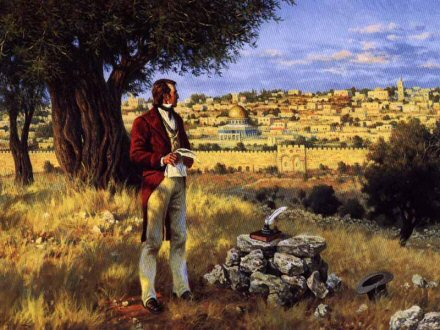
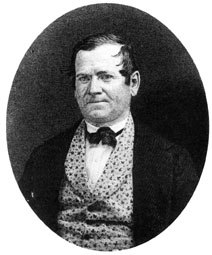
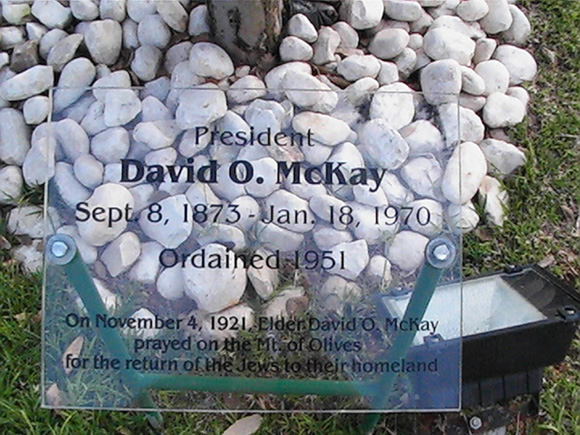
David O McKay, a Prophet,
prayed for return of the Jews to Homeland.
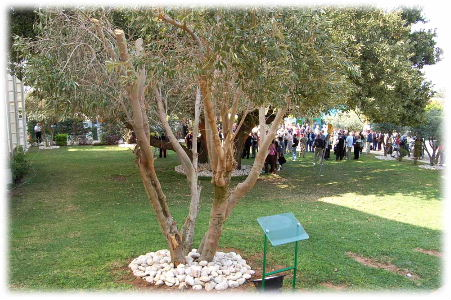
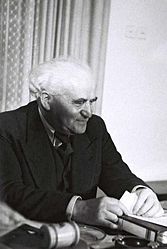
David Ben Gurion
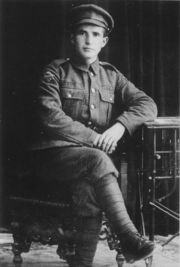
Private David Ben Gurion